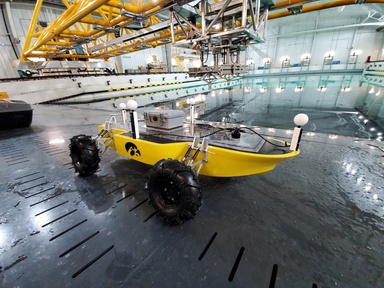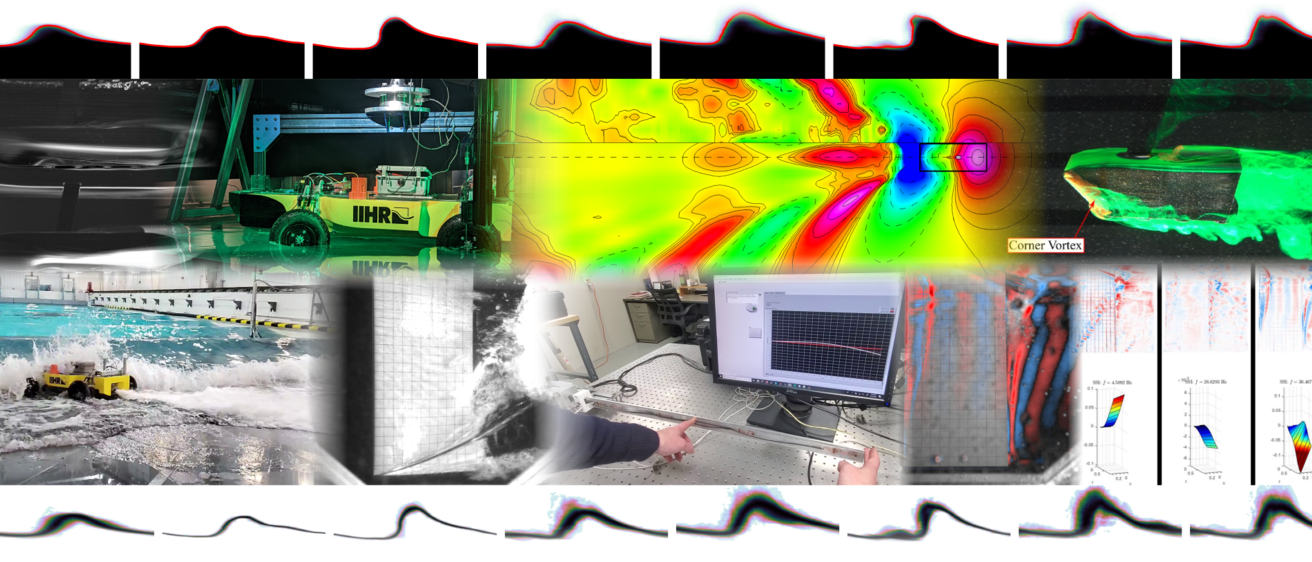Current Research Areas
Amphibious Vehicle Dynamics and Control
Advancing our collective ability to assess amphibious platforms in challenging environments
The MaST lab has established an international reputation for its work in surf zone hydrodynamics and amphibious vehicle research. Our unique experimental capabilities allow us to test -- repeatably -- controlled transits of small amphibious robotic craft across controlled, scale-model coastal surf conditions.
The objectives of this work are:
- Establish a first-of-its-kind dataset describing the dynamics of small amphibious vehicles crossing coastal surf zones for use by simulators, roboticists, and designers.
- Develop experimental techniques and procedures to enable repeatable surf zone transits.
- Study the effects of vehicle speed, thrust, entry angle, and transit direction upon vessel motions during surf-zone transits.
- Study the controllability of small amphibious craft in breaking waves.
Fluid Structure Interactions
Gaining understanding of complex fluid-structure interactions for improved modeling and design
Fluid-structure interaction describes the effects of fluid dynamic forces upon flexible structures – such as wings, bridges, or ship hulls – and vice versa. Prediction, modeling, and monitoring of fluid-structure interactions are necessary capabilities for avoiding fluid-induced failures in engineered systems critical to transportation and infrastructure. At the same time, targeted structural vibration holds promise as a method of flow-control, with applications that include improved stall resistance of aircraft wings or drag reduction on bluff-bodies such as tractor trailers or large maritime vessels.
Current experimental methods do not paint a complete picture of the potential hazards or the realizable benefits of fluid-structure interaction. The principal aim of this research is a deeper and more actionable understanding of the mutual effects of flexible structures and fluids upon one another, and how those effects can be leveraged for improved safety and performance.
In the MaST Lab, we use custom sensors and high-end flow imaging to measure the fluid and structure at the same time. With state-of-the-art analysis techniques, we paint a holistic picture of the way that fluid flows affect structural motions - and vice versa.
Sensor Design
Enabling accurate, low-cost, real-time monitoring of flexible structures.

Our Kinematic Shape Sensing (KSS) methodology unlocks insight into the static and dynamic deformations of simple structures without the need for cameras or high-cost fiber-optic instrumentation. Through a novel application of conventional strain gauges, combined with a kinematic reconstruction model, we can reconstruct the deformations of beam-like and plate-like structures with precision matching that of photogrammetric methods, without the effect of integration drift, and at rates of up several kilohertz. As a result, they are valuable for structural health monitoring, inverse modeling, and operational modal analysis.
These sensors underpin the MaST lab's research on fluid-structure interaction by enabling detailed measurements of fluid-loaded structural displacements.
Multi-Phase Flows
Understanding the behaviors and quantifying the effects of ventilation and cavitation.
As an expert in ventilated flows, Dr. Harwood has collaborated with other researchers at universities and research centers around the world to study multi-phase flows around surface-piercing hydrofoils. Our work has set a standard for high-quality experimentation, and has paved the way for new understanding of the hydrodynamic and hydroelastic responses of rigid and flexible surface-piercing lifting surfaces.
Dynamic System Emulation and System Identification
Using robotic manipulators to accelerate the modeling and emulation of marine vehicles
Unsteady vehicle motions produce fluid reaction loads that are difficult to model and predict.
The MaST lab, in collaboration with the HIR lab at the University of Iowa, have designed and built a 6-Degree-of-Freedom Stewart Platform or "hexapod" to be installed in the IIHR towing tank.

As part of this project, researchers will use the hexapod to prescribe dynamic motions of surface and submersible models, measure the fluid reaction forces, and generate system based models that can help develop autopilots and controllers of advanced vehicles.
The hexapod is capable of high speeds up to 1 m/s, heavy payloads of 500 kg, and extremely precise motions, with dynamic positioning errors measured in hundredths of an inch.
